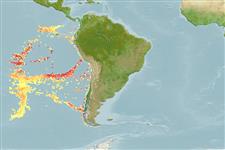Holothuroidea |
Apodida |
Chiridotidae
Environment: milieu / climate zone / depth range / distribution range
Ecology
Benthic; depth range 2000 - 2830 m (Ref. 474). Tropical
Central Pacific: Manus and North Fiji basins and East-Pacific Ridge.
Length at first maturity / Size / Weight / Age
Maturity: Lm ? range ? - ? cm Max length : 26.0 cm TL male/unsexed; (Ref. 474); common length : 0.0 cm male/unsexed; (Ref. )
Opportunistic. Lives on different biotopes, e.g., gastropod and mussel beds, barnacle fields, rock cracks. Has the ability to switch between suspension- and deposit-feeding (Ref. 474).
Life cycle and mating behavior
Maturity | Reproduction | Spawning | Eggs | Fecundity | Larvae
Members of the class Holothuroidea are gonochoric and have only one gonad. Spawning and fertilization are both external and some exhibit brooding. Life cycle: Embryos develop into planktotrophic larvae (auricularia) then into doliolaria (barrel-shaped stage) which later metamorphose into juvenile sea cucumbers.
Smirnov, A.V., A.V. Gebruk, S.V. Galkin and T. Shank 2000 New species of holothurian (Echinodermata: Holothuroidea) from hydrothermal vent habitats. Journal of the Marine Biological Association (UK) 80:321-328. (Ref. 474)
IUCN Red List Status
(Ref. 130435: Version 2025-1)
CITES status (Ref. 108899)
Not Evaluated
Not Evaluated
Threat to humans
Human uses
| FishSource |
Tools
More information
Trophic EcologyFood items (preys)
Diet composition
Food consumption
Predators
Population dynamicsGrowth
Max. ages / sizes
Length-weight rel.
Length-length rel.
Length-frequencies
Mass conversion
Abundance
Life cycleReproductionMaturityFecunditySpawningEggsEgg developmentLarvae PhysiologyOxygen consumption
Human RelatedStamps, coins, misc.
Internet sources
Estimates based on models
Preferred temperature
(Ref.
115969): 1.8 - 1.9, mean 1.9 (based on 14 cells).
Fishing Vulnerability
Low vulnerability (16 of 100).
Price category
Unknown.
